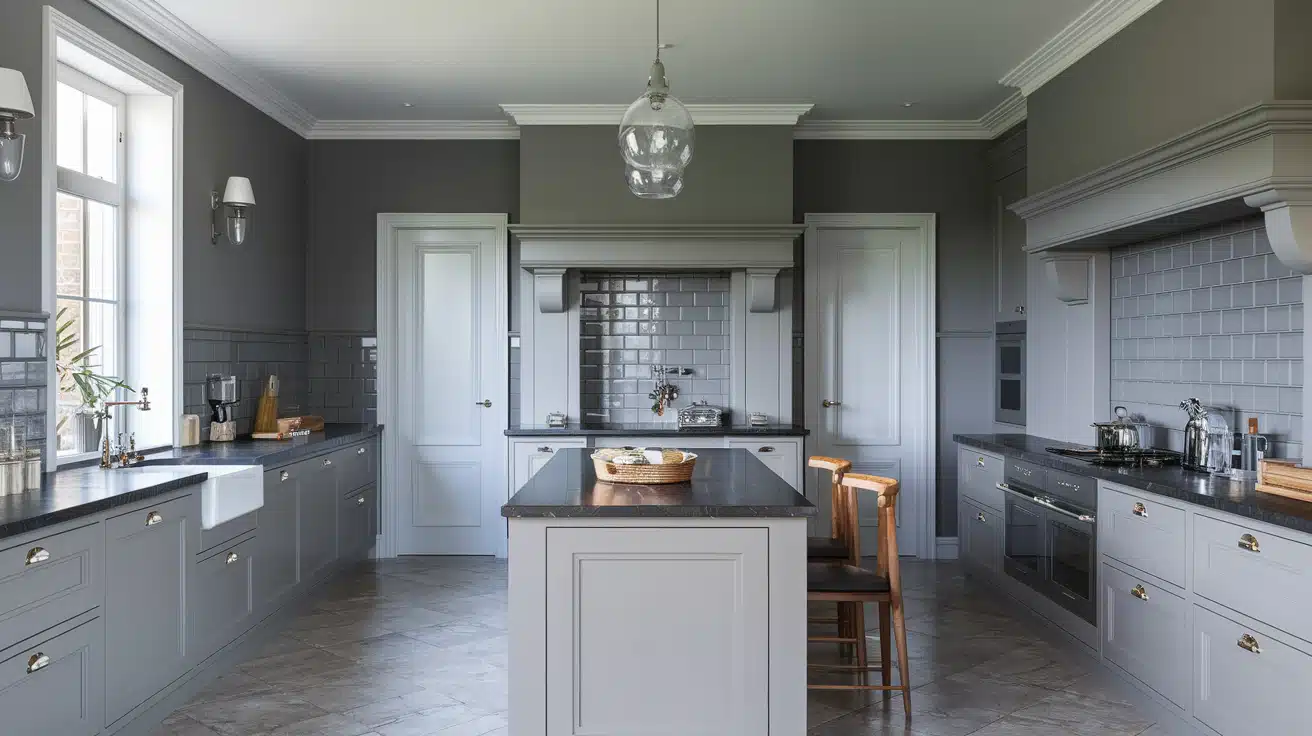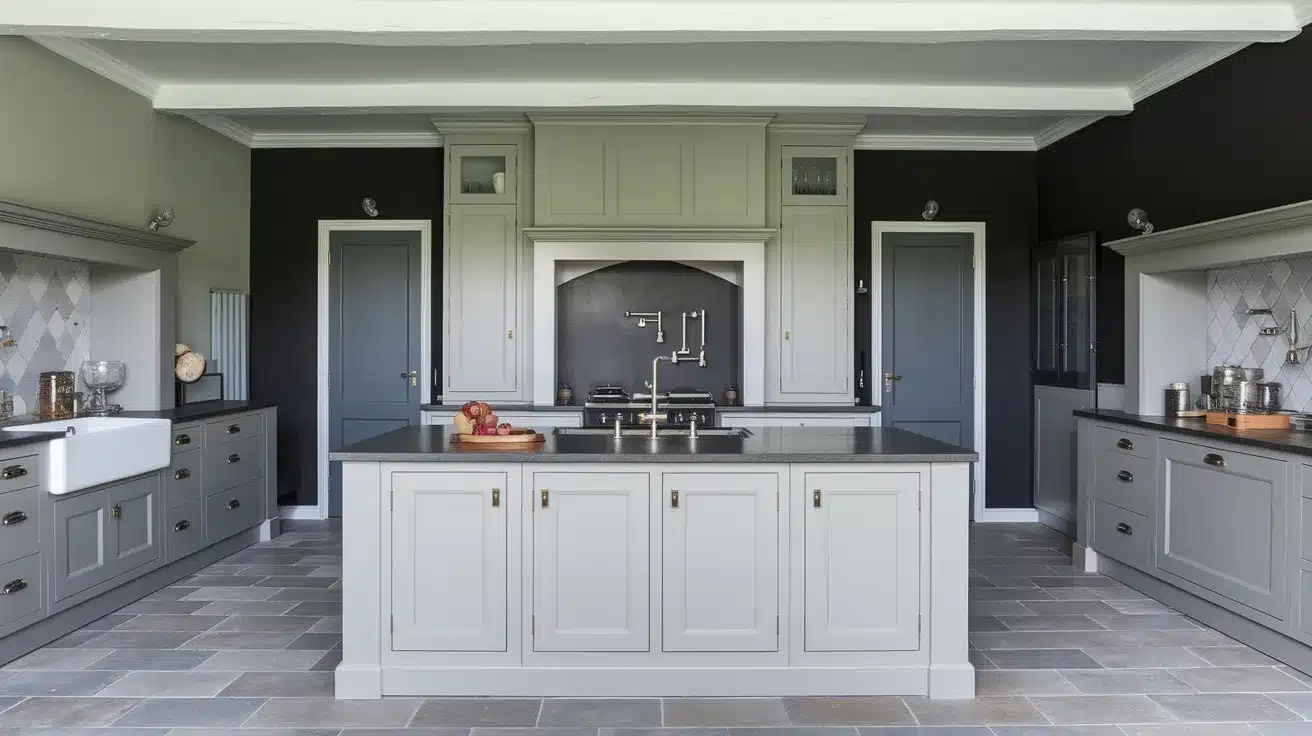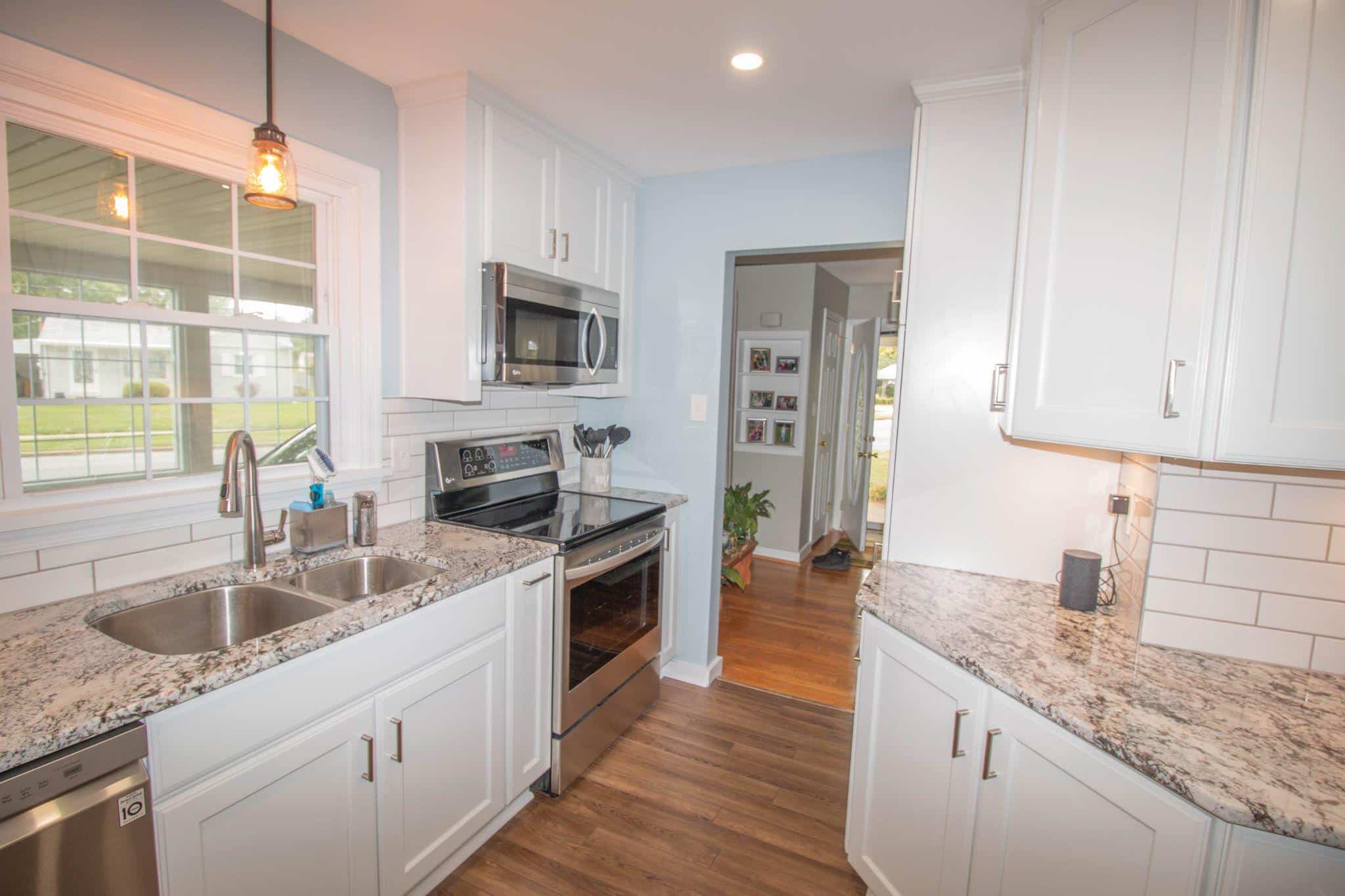Modern kitchens often feel cold and stark with all-white designs, while dark colors can make the space feel small and gloomy.
I understand this challenge because I spent months finding the right balance for my kitchen.
The good news is that grey offers the perfect middle ground. When used correctly, this versatile color can warm and invite your kitchen while maintaining a clean, modern look.
It pairs beautifully with any accent color and works well in small and large spaces.
In this article, I’ll show you five practical ways to use grey in your kitchen, from choosing the right shade to combining it with other colors.
You’ll learn how to create a space that feels both sophisticated and welcoming.
Understanding the Different Shades of Grey

Light Grey Shades for an Airy, Open Kitchen
Looking to brighten up your cramped kitchen space? Light grey shades offer the perfect solution, as they can make even the smallest kitchen feel more spacious and inviting.
1. Soft and Subtle Grey for Small Kitchens
Small kitchens can feel cramped and confined, but using light grey shades like Dove Grey or Silver Satin can help create the impression of more space.
These gentle tones reflect light effectively, making the room feel bigger and more open.
When your kitchen gets limited natural light, these pale grey shades work particularly well because they help brighten up the space rather than absorbing light as darker colors do.
2. Blending Light Grey with Bright Accents
Light grey provides an excellent base for adding bright colors. You can include colorful appliances, dishes, or decor items that stand out against the neutral backdrop.
This combination creates a fresh, modern feel without overwhelming the space.
Dark Grey Shades for Bold, Cozy Kitchens
1. Charcoal and Slate Grey for a Sophisticated Look
Large kitchens benefit from deeper grey shades, which add character and comfort to spacious areas.
Dark grey tones create an intimate atmosphere in larger kitchens while maintaining a refined appearance.
These deeper shades work wonderfully in spaces with plenty of natural light.
2. Pairing Dark Grey with Light Elements
Creating contrast helps balance dark grey walls. Consider matching them with white cabinets or countertops to create visual interest.
This combination prevents the space from feeling too dark while maintaining the rich, warm atmosphere that dark grey provides.
Choosing the Right Grey Based on Your Kitchen Style
Grey for Modern and Minimalist Kitchens
1. Cool-Toned Greys for Sleek Finishes
Cool-toned greys like Concrete Grey or Fog Grey work exceptionally well for a clean, current look. These shades create a smooth, understated background that perfectly fits modern kitchen designs.
The key is selecting a grey tone that enhances a minimalist space’s simple lines and uncluttered feel.
2. Pairing Grey with Metal and Glass
Grey creates a perfect background for stainless steel appliances and glass fixtures. The color naturally complements metallic surfaces, creating a unified look throughout your kitchen.
Glass elements, such as pendant lights or cabinet doors, add brightness and reflection that works beautifully with grey walls.
Grey for Classic and Traditional Kitchens
1. Soft, Muted Greys for Timeless Appeal
In traditional kitchens, lighter greys like Light Pewter blend smoothly with wooden elements and classic cabinet styles.
These softer shades respect the traditional character of your kitchen while updating it subtly. The key is choosing warmer grey tones that work with existing wood finishes.
2. Adding Texture to Your Grey Kitchen
Including different textures helps create depth in a grey kitchen. Consider wood finishes with natural grain patterns, tile backsplashes with subtle patterns, and stone countertops with natural variations.
How to Complement Grey Walls with Other Design Elements
Grey Cabinets: A Statement of Style
1. Matching Grey Cabinets with Light or Dark Walls
The key to successful cabinet and wall pairing lies in contrast levels. Light grey cabinets work well with darker walls, while dark grey cabinets pop against lighter backgrounds.
This creates balance and visual interest in your kitchen space.
2. Grey Cabinets in Modern and Rustic Kitchens
Grey cabinets suit both modern and farmhouse-style kitchens. For contemporary spaces, choose smooth finishes and clean lines. In farmhouse settings, opt for textured finishes and traditional hardware.
Flooring and Backsplashes to Match Your Grey Walls
1. Grey Floors for a Unified Look
Consider options like tiles, wood, or polished concrete in complementary grey tones. The key is choosing flooring that doesn’t compete with your walls but enhances the overall color scheme.
2. Contrasting or Complementing Grey with Backsplashes
Select backsplashes based on your kitchen’s style. Solid colors work well in modern kitchens, while patterned tiles add interest to traditional spaces. Consider the wall shade when choosing between contrast or harmony.
The Impact of Lighting on Grey Kitchens
Natural Light and Grey: A Perfect Pairing
Position mirrors strategically to reflect natural light. Keep window treatments minimal, and consider glass cabinet doors to help light flow through the space.
Morning light tends to be cooler, while afternoon sun adds warmth. Test paint samples at different times of day to see how the light affects the color.
Artificial Lighting and Grey Kitchen Walls
Warm lighting adds coziness to cool grey tones, while cool lighting helps maintain the crispness of warmer greys. Layer different light sources to create flexibility in your lighting scheme.
Adding Color Accents to Your Grey Kitchen
Bold Color Accents for a Fun Touch: Add life to your grey kitchen with colorful accessories and appliances. Small items like bowls, utensils, or tea towels can significantly impact without a permanent commitment.
Using Neutral Accents for a Subtle Pop: Whites, blacks, or beige tones create a minimalist look while adding depth to your grey palette. These neutral accents maintain the kitchen’s sophisticated feel.
Metallic Finishes to Complement Grey Walls: Hardware, light fixtures, and faucets in metallic finishes add shine and interest. Mix metals thoughtfully to create a layered, custom look.
Tips for Painting Your Kitchen Grey
Surface Prep and Primer for a Smooth Finish
Clean walls thoroughly and repair any damage before painting. Use quality primer designed for kitchen environments to ensure the paint adheres properly.
Choosing the Right Paint Finish
Consider durability and cleaning needs. Semi-gloss works well for high-traffic areas, while matte finishes suit less-used spaces.
Conclusion
Grey isn’t just another color choice for your kitchen – it’s a versatile tool that can completely change how your space feels and functions.
From light greys that open up small spaces to deep charcoal tones that add warmth to larger kitchens, each shade offers unique possibilities for your home.
Ready to try grey in your kitchen? Start small. Paint a sample section of your wall and observe it throughout the day. Notice how it looks in morning light versus evening light.
Try pairing it with different colored accessories.
Remember, there’s no single “right” shade of grey – the best choice is the one that makes your kitchen feel like home.












